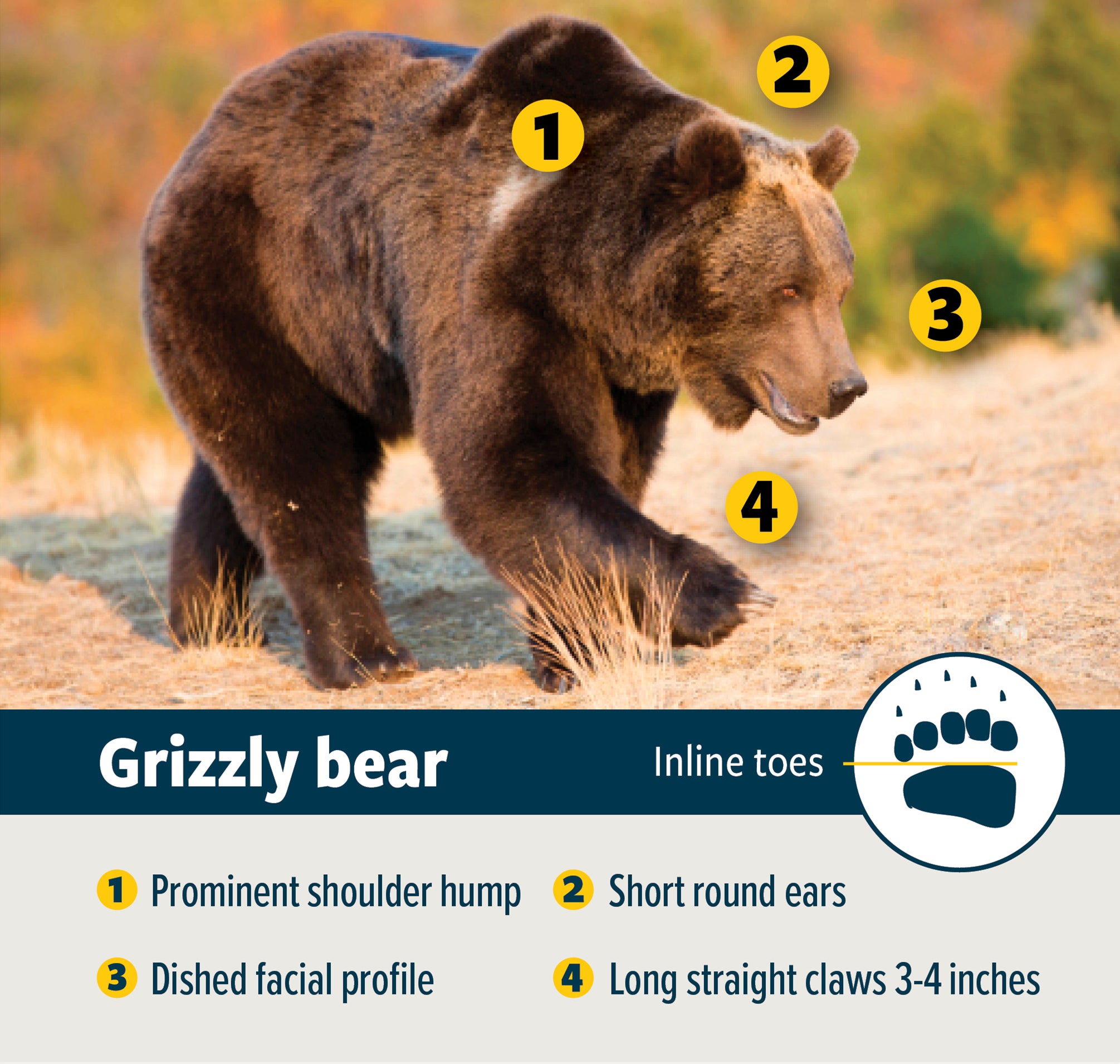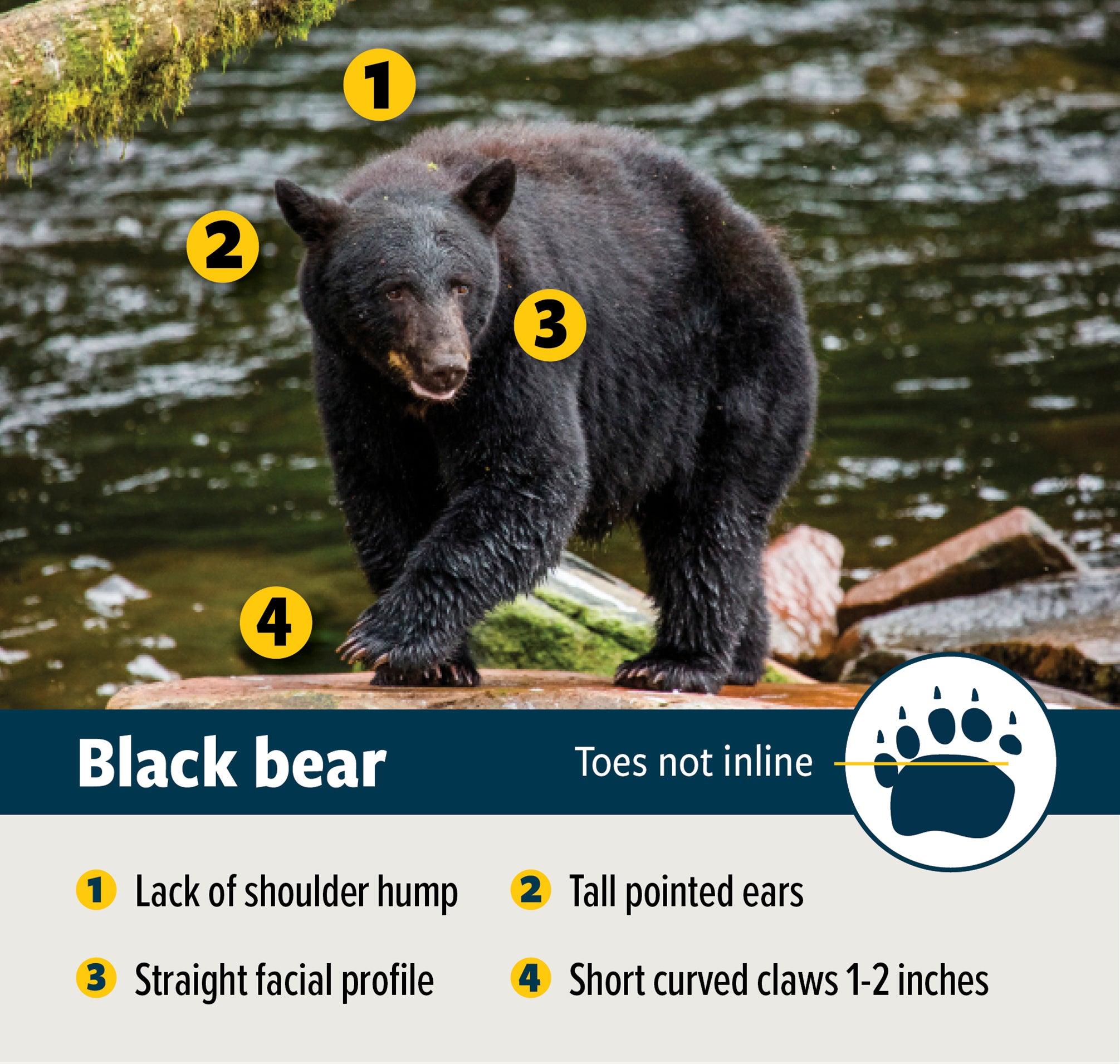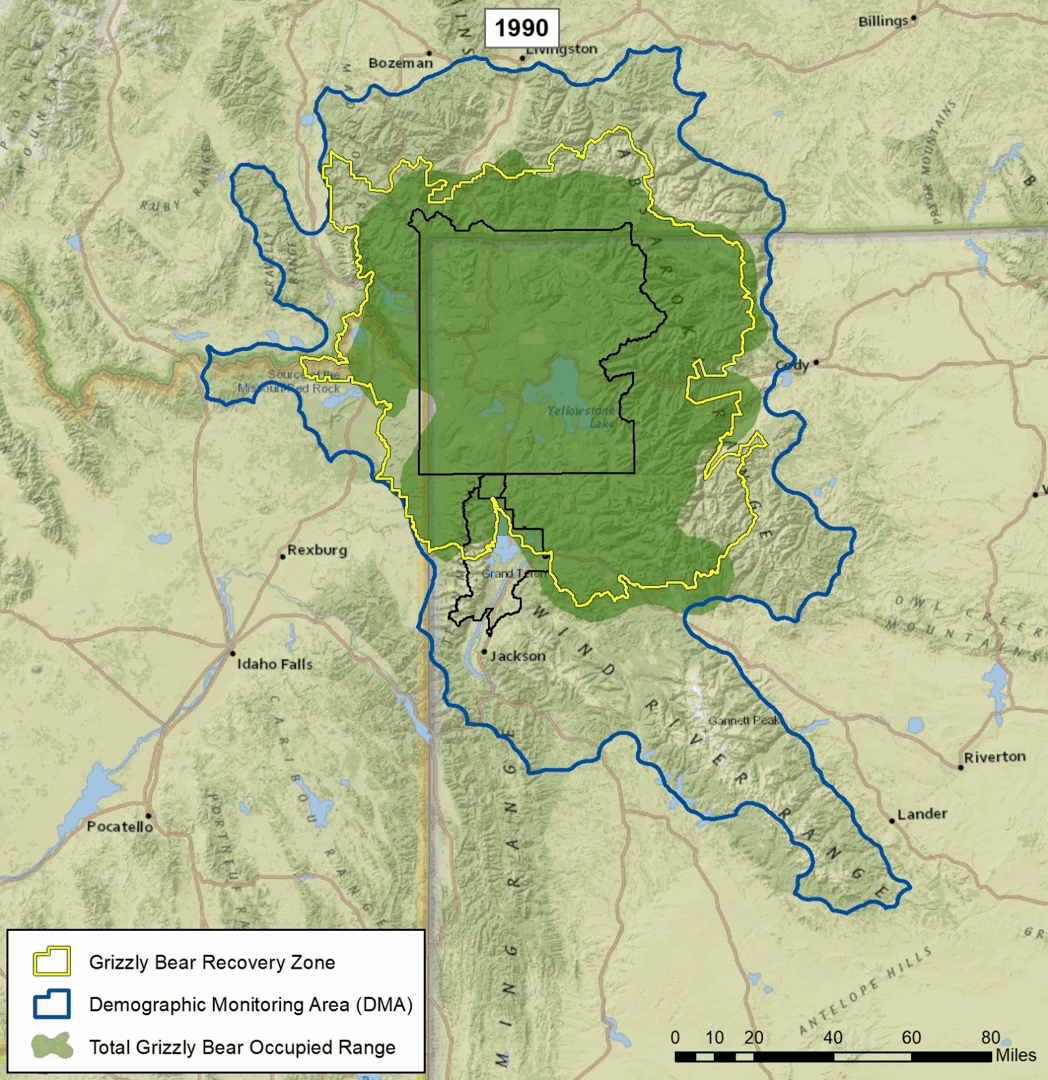Grizzly Bears in Wyoming
Grizzly bears that can be found throughout northwest Wyoming are a part of the Yellowstone area grizzly bear population. The Wyoming Game and Fish Department has an extensive grizzly bear management program that includes research and monitoring, conflict management, education and outreach. The foundation of this program is rooted in education and outreach and working with the public to reduce the potential for conflict between grizzly bears and people.
Learn about how the Wyoming Game and Fish Department monitors grizzly bear populations, how conflicts between humans and bears are managed and how to stay safe in bear country.
View the grizzly bear snapshot

Stay safe in bear county.
Bear Wise Wyoming
Wyoming is bear country. Learn what to do in an encounter situation, how to avoid attracting a bear to your home or camp, how to minimize your risk while recreating in areas occupied by bears.
Know your bears
Wyoming is home to both black bears and grizzly bears.
Learn how to determine species by looking for a combination of four key characteristics that distinguish black bears from grizzly bears. Never use just color or size to identify a bear.


About grizzly bears in Wyoming
Grizzly bears are a symbolic icon of wilderness in Wyoming and a wildlife conservation success story. Wyoming has always been home to grizzly bears and the work of the people that live, work and recreate in grizzly bear country has successfully recovered this population from the brink of extirpation. Grizzly bears populations are now thriving in Wyoming, with high densities existing throughout suitable habitat for the species. Grizzly bear populations have biologically recovered in Wyoming, however grizzly bears are currently listed as a threatened population under the Endangered Species Act.
Because grizzly bears are inherently more aggressive than their black bear counterparts, the Wyoming Game and Fish continually works to reduce conflict potential between grizzly bears and humans through education and outreach.
Phylum: Chordata
Class: Mammalia
Order: Carnivora
Family: Ursidae
Subfamily: Ursinae
Genus: Ursus
Species: arcto
How do we monitor grizzly bears?
Grizzly bears have been intensively monitored in Wyoming for multiple decades. The population is managed cooperatively by state, federal and local agencies across jurisdictional boundaries in the Greater Yellowstone Ecosystem (GYE) through the Tri-State Memorandum of Agreement. The Wyoming Game and Fish Department takes the lead in monitoring grizzly bears in the GYE, and personnel from the large carnivore section annually capture grizzly bears to maintain a representative sample of the population. Captured bears are fitted with tracking collars and data from these collars helps biologists gain insight into survival, reproduction and mortality and overall condition of the larger population. In addition, monitoring provides information about habitat use and fine scale movements.
Distribution of Grizzly Bears in Wyoming
The map depicts the approximate area frequented by grizzly bears. It should be noted that grizzlies may be present outside of known distribution areas.
Annual Reports

History of grizzly bears in Wyoming
1975
Grizzly bears listed as threatened under the Endangered Species Act.
1983
The Interagency Grizzly Bear Committee was formed to coordinate on bears in the Lower 48 states. Staffed by federal, state, tribal and local interests, the committee makes recommendations to the U.S. Fish and Wildlife Service regarding the listing status of the bear in the lower 48.
1982
The USFWS issues the Grizzly Bear Recovery Plan.
1993
The USFWS defines three specific goals for recovery. The goals must be met for six consecutive years: population goal, human-caused cub mortality limits and adult male mortality limits.
2000
The draft Conservation Strategy is complete. It includes the management approach and allows for biologically and socially suitable expansion of bears outside the conservation area.
2002
Wyoming Grizzly Bear Management plan completed, outlining the plan for state management following delisting.
2002
The Conservation Strategy is approved. This will take effect once grizzlies are recovered.
2003
All recovery criteria are met in the GYE grizzly bear population. The USFWS moves forward with a delisting rule.
2005
USFWS proposed to remove grizzly bears from the threatened list.
2006
The Grizzly Bear Recovery Plan is revised with new standards for estimating populations and mortality limits.
2007
The delisting rule is drafted and published. Bears are delisted March 22 and Wyoming assumes management authority for the first time since being listed.
2007
The delisting rule is challenged with several lawsuits based on four “issues”: The Conservation Strategy is not enforceable Inadequate regulatory mechanisms Impacts of the decline of whitebark pine were not sufficiently examined source Concerns over genetic connectivity
2009
Bears are relisted in September and two criteria are upheld: The Conservation Strategy and state plans are inadequate. The loss of whitebark pine as a food source was not adequately considered
2010
USFWS and the Department of Justice appeal the relisting to the 9th Circuit Court in San Francisco, arguing the judge did not consider information on the whitebark pine provided in a USFWS legal briefing, and should have “deferred to the opinion of federal experts to interpret biology.
2011
9th Circuit Court rules on three of the four criteria. Whitebark pine decline must be further considered, but says the regulatory mechanisms are adequate.
2013
The Food Synthesis Report from the Interagency Grizzly Bear Committee demonstrates that whitebark pine decline had no significant impact on the grizzly bear population. That report is delivered to USFWS.
2016
USFWS moves forward with proposed delisting rule.
2016
Wyoming Game and Fish updates their Grizzly Bear Management Plan and holds multiple public forums to gather insight into how Wyomingites want grizzly bear management to proceed within the state. The Conservation Strategy is also updated with the most recent recovery criteria and population demographic information.
2017
USFWS establishes a new population threshold for 600 bears and a management objective of 674. Bears are delisted and Wyoming assumes management authority for the second time.
2018
Wyoming plans a conservative grizzly bear hunt. A United States District Judge in Montana ruled in favor of the Crow Indian Tribe, other tribes and environmental groups halting the hunt. The judge ruled bears must be relisted based on three considerations: Impact on ecosystems Connectivity Methods of population estimates The USFWS relisting is appealed.
2019
The Federal Department of Interior; the states of Idaho, Montana, Wyoming and advocacy organizations file to the Federal Court of Appeals to delist the grizzly bear.
2020
A federal appeals court in San Francisco upheld the Montana district court’s opinion that the bears living in the GYE will remain listed as threatened, stating long-term genetic effects on other grizzly bear populations across the country and the need to study the population further.
2020
USFWS initiates a 5-year status review of grizzly bears in the conterminous United States under the Endangered Species Act. A 5-year status review is based on the best scientific and commercial data available at the time; the last review of the species was in 2011.
